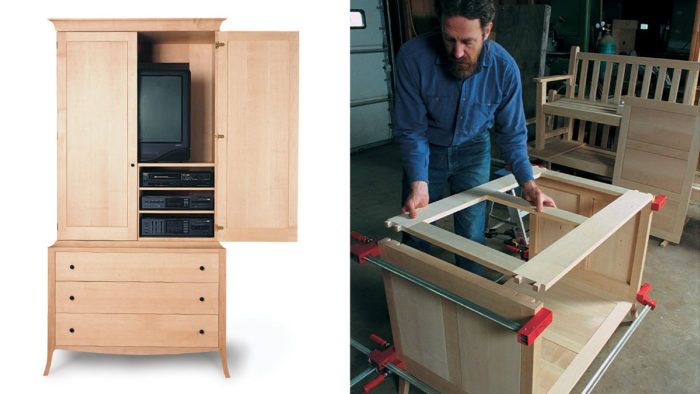Entertainment Center in Quartersawn Maple
Curved elements and cove moldings help keep a big case from looking boxy
Synopsis: Peter Turner’s design for an entertainment center avoids bulkiness by maximizing usable internal space and adding soft curves to the exterior. Cranked door hinges allow the door to open 270°, and hidden, full-extension slides allow easy access to the backs of the drawers. Detailed project plans will help you build the entertainment center and understand the fine points of the frame-and-panel base, dovetailed upper case, and the waist and crown molding. Side information offers options for pulls that won’t ding the case.
As my 2-year-old daughter, Morrigan, grew and became more mobile and curious, so did the urgency to design and build an entertainment center. My aim was to keep the unit looking more like a piece of furniture than a refrigerator while efficiently housing the television, VCR, and other audio components out of sight and temptation’s way.
In an effort to move away from the large, heavy look of a typical entertainment center, my first design ended up as a horizontal case on a skinny, four-legged frame. I eventually scrapped this design because I realized the weight of components, especially a television, would overwhelm such a delicate piece. Instead, the cabinet evolved into a more conventional two-piece structure, with a lower section housing three drawers for storage of CDs and tapes and a slightly narrower but taller upper section enclosed by a pair of doors. I did what I could to keep the piece from getting bulky by maximizing the usable internal space and adding soft curves to the exterior, which help mask its rather hefty dimensions.
I chose cranked door hinges that allow a door to be opened a full 270° instead of pocket door hardware, which would have added several inches to the width of the piece. The curved legs lift the case off the floor and help reduce its visual weight. And to blend the lower case with the upper, I applied cove moldings at the waist and at the crown. I really like the Sam was assigned the upper case, and I took on the lower box. We kept our fingers crossed and hoped that the bridge would eventually meet in the middle.
Quartersawn maple is the predominant wood used in the piece. The wood was chosen for its light color and subtle grain. Soft maple was used for the drawer sides and one internal frame. The drawer bottoms are made of plywood.
My local hardwood supplier, Dennis Day of Day Hardwoods in Scarborough, Maine, has a knack for finding high-quality wood at fair prices. He supplied me with 200 bd. ft. of quartersawn maple with several pieces close to 8 in. wide, unusually wide for quartersawn stock. The widest planks were used for visible panels and drawer fronts. The narrower stock was used for frames, internal panels and shelves.
We were unable to locate thicker quartersawn stock, so we used plainsawn material when needed, sawing it to best show off the grain.
From Fine Woodworking #139
For the full article, download the PDF below:
Fine Woodworking Recommended Products

Dubuque Clamp Works Bar Clamps - 4 pack

Stanley Powerlock 16-ft. tape measure

Starrett 12-in. combination square























Log in or create an account to post a comment.
Sign up Log in